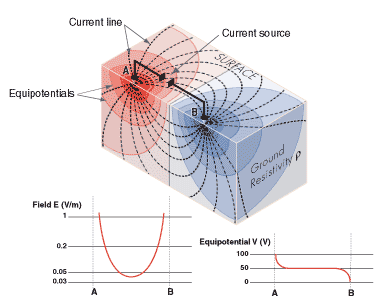In fact in practice, there are two current electrodes. The current sent by A (+) will be collected by B (-), but according to the principle of superposition, the potential in a point M will be the same one if we send independently a current +I by A or a current +I by B.
In addition, the laws which govern the propagation of the electrical phenomena are linear, which means that we can algebrically add the potentials created by various sources. The total potential in a point will be Vtot = V1 + V2 for two current poles.
|
|
the sign ± is determined by the sign of the electrodes
|
The expression of the potential shows that in an homogeneous and isotropic formation, equipotential surfaces will be for one current pole half spheres centered on this pole. For two poles their form will be more complicated but they will remain appreciably spherical in the vicinity of electrode A and B.The current flow lines which would be lines resulting from the current pole if this one is unique gradually curve to join the second electrode.

![]() Equipotentials and current flow lines for two sources of current.
Equipotentials and current flow lines for two sources of current.
The curves represented on the figure above show the evolution of the potential and of its gradient, the field E. The fields V and E are appreciably uniform in the central third part of AB while the major part of the fall of potential is localised in the immediate vicinity of electrodes A (+) and B (-), that means that almost the totality of the resistance which offers the formation to the flow of the current comes from the immediate vicinity of electrodes A and B. For example for an electrode of diameter a, 90% of the resistance of the circuit is located in a sphere of radius 10a, the remainder of the formation having a very weak contribution, it will be thus impossible to know the nature of the underground by the study of resistance between two points. The deep layers of the basement appear only by their influence on the distribution of the potential to the central third of the configuration, from where we need to measure the potential. In addition, when the resistance of contact is very significant few current passes in the underground. Consequently it is recommended to try to decrease this resistance (we can increase the number of batteries, decrease the resistance of contact by watering the electrodes, increase the number of electrodes, etc...)